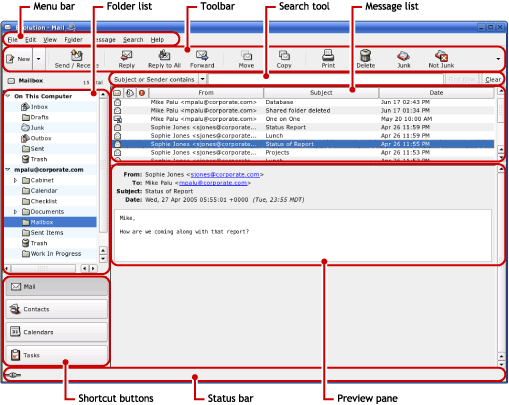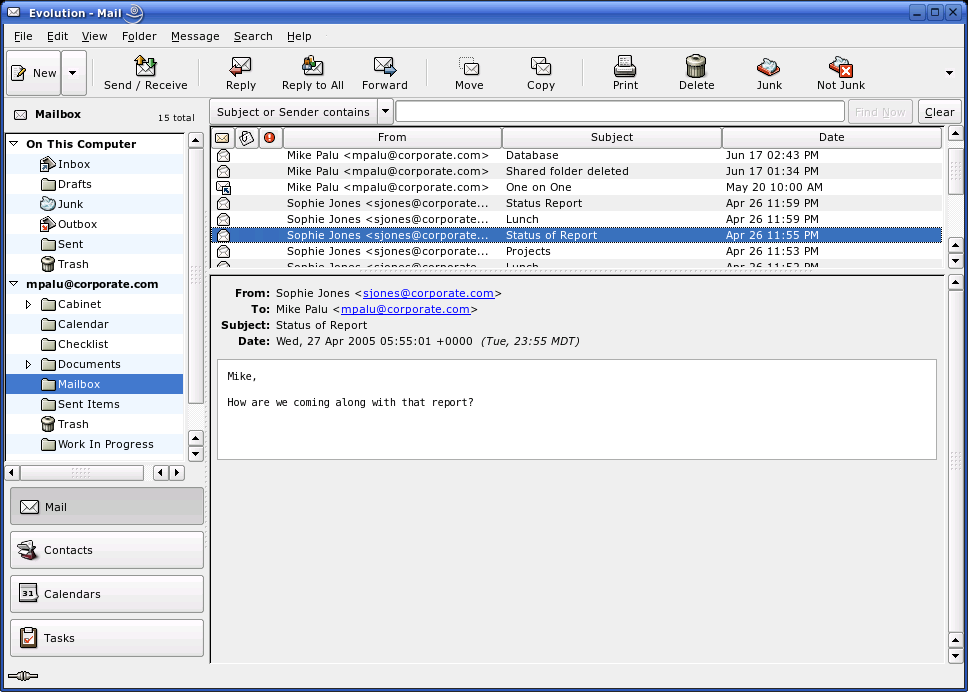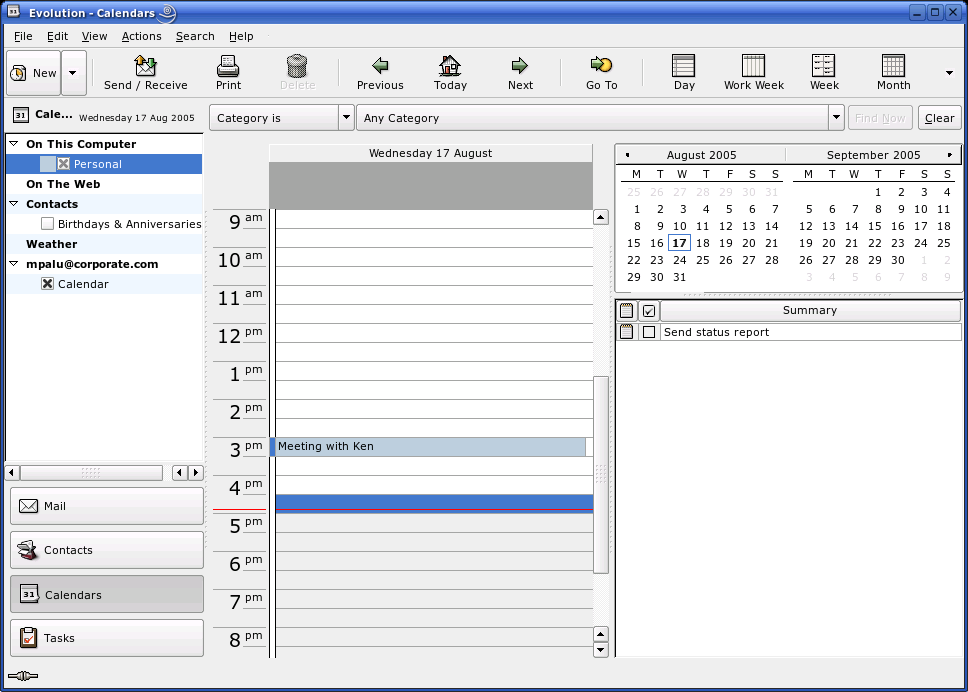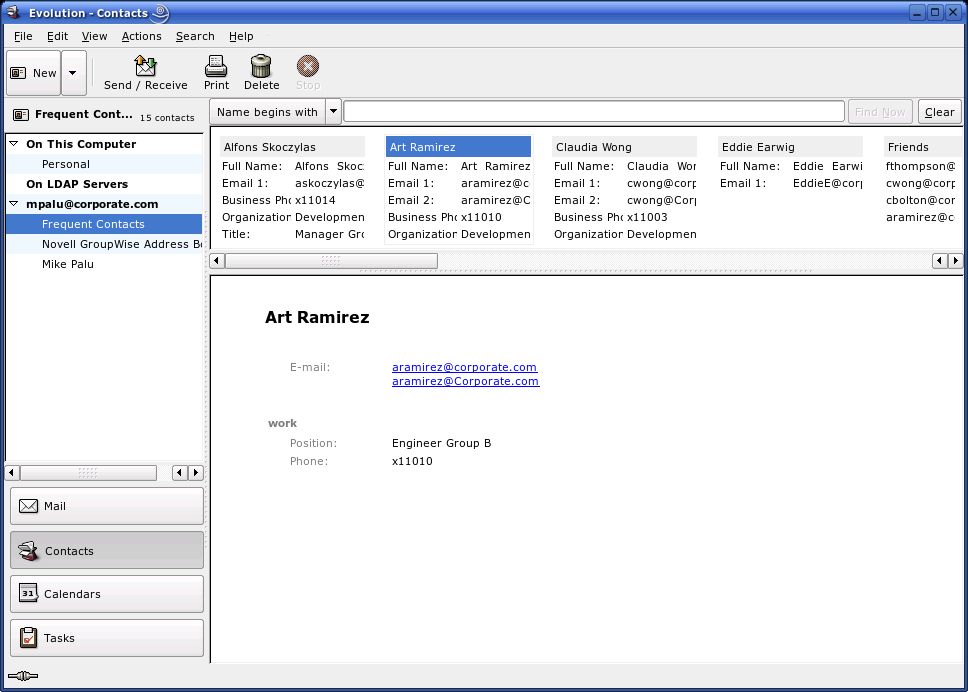Using Evolution: An Overview
Now that the first-run configuration has finished, you're ready to begin using Evolution. Here's a quick explanation of what's happening in your main Evolution window.

Menu Bar
The menu bar gives you access to nearly all of Evolution features. For additional information, see The Menu Bar.
Folder List
The folder list gives you a list of the available folders for each account. To see the contents of a folder, click the folder name and the contents are displayed in the e-mail list.
Toolbar
The toolbar gives you fast and easy access to the frequently used features in each component.
Search Tool
The search tool lets you search your e-mail, contacts, calendar, and tasks to easily find what you're looking for.
Message List
The message list displays a list of e-mail that you have received. To view an e-mail in the preview pane, click the e-mail in the e-mail list.
Shortcut Buttons
The shortcut bar lets you switch between folders and between Evolution tools. At the bottom of the shortcut bar there are buttons that let you switch tools, and above that is a list of all the available folders for the current tool. If you have the Evolution Connector for Microsoft Exchange installed, you have an Exchange button in addition to buttons for the other tools. For additional information, see The Shortcut Bar.
Status Bar
The status bar periodically displays a message, or tells you the progress of a task. This most often happens when you're checking or sending e-mail. These progress queues are shown in the previous figure. The Online/Offline indicator is here, too, in the lower left of the window.
Preview Pane
The preview pane displays the contents of the e-mail that is selected in the e-mail list.
The Menu Bar
The menu bar's contents always provide all the possible actions for any given view of your data. If you're looking at your Inbox, most of the menu items relate to e-mail. Some content relates to other components of Evolution and some, especially those in the File menu, relates to the application as a whole.
File: Anything related to a file or to the operations of the application usually falls under this menu, such as creating things, saving them to disk, printing them, and quitting the program itself.
Edit: Holds useful tools that help you edit text and move it around. Lets you access the settings and configuration options in the Edit menu.
View: Lets you decide how Evolution should look. Some of the features control the appearance of Evolution as a whole, and others the way a particular kind of information appears.
Folder: Holds actions that can be performed on folders. You can find things like copy, rename, delete, and so on.
Message: Holds actions that can be applied to a message. If there is only one target for the action, such as replying to a message, you can normally find it in the Message menu.
Search: Lets you search for messages, or for phrases within a message. You can also see previous searches you have made. In addition to the Search menu, there is a text entry box in the toolbar that you can use to search for messages. You can also create a search folder from a search.
The Shortcut Bar
Evolution's most important job is to give you access to your information and help you use it quickly. One way it does that is through the shortcut bar, which is the column on the left side of the main window. The buttons, such as Mail and Contacts, are the shortcuts. Above them is a list of folders for the current Evolution tool.
The folder list organizes your e-mail, calendars, contact lists, and task lists in a tree, similar to a file tree. Most people find one to four folders at the base of the tree, depending on the tool and their system configuration. Each Evolution tool has at least one, called On This Computer, for local information. For example, the folder list for the e-mail tool shows any remote e-mail storage you have set up, plus local folders and search folders, which are discussed in Using Search Folders.
If you get large amounts of e-mail, you might want more folders than just your Inbox. You can create multiple calendar, task, or contacts folders.
To create a new folder:
-
Click Folder > New.
-
Type the name of the folder in the Folder Name field.
-
Select the location of the new folder.
-
Click OK.
Folder Management
Right-click a folder or subfolder to display a menu with the following options:
Copy: Copies the folder to a different location. When you select this item, Evolution offers a choice of locations to copy the folder to.
Move: Moves the folder to another location.
Mark Messages As Read: Marks all the messages in the folder as read.
New Folder: Creates another folder in the same location.
Delete: Deletes the folder and all its contents.
Rename: Lets you change the name of the folder.
Disable: Disables the account.
Properties: Checks the number of total and unread messages in a folder, and, for remote folders, lets you select whether to copy the folder to your local system for offline operation.
You can also rearrange folders and messages by dragging and dropping them.
Any time new e-mail arrives in a e-mail folder, that folder label is displayed in bold text, along with the number of new messages in that folder.
E-Mail
Evolution e-mail is like other e-mail programs in several ways:
- It can send and receive e-mail in HTML or as plain text, and makes it easy to send and receive multiple file attachments.
- It supports multiple e-mail sources, including IMAP, POP3, and local mbox or mh spools and files created by other e-mail programs.
- It can sort and organize your e-mail in a wide variety of ways with folders, searches, and filters.
- It lets you guard your privacy with encryption.
However, Evolution has some important differences from other e-mail programs. First, it's built to handle very large amounts of e-mail. The junk e-mail, message filtering and searching functions were built for speed and efficiency. There's also the search folder, an advanced organizational feature not found in some e-mail clients. If you get a lot of e-mail, or if you keep every message you get in case you need to refer to it later, you'll find this feature especially useful. Here's a quick explanation of what's happening in your main Evolution e-mail window.

Message List
The message list displays all the e-mails that you have. This includes all your read and unread messages, and e-mail that is flagged to be deleted.
Preview Pane
This is where your e-mail is displayed.
If you find the preview pane too small, you can resize the pane, enlarge the whole window, or double-click the message in the message list to have it open in a new window. To change the size of a pane, drag the divider between the two panes.
As with folders, you can right-click messages in the message list and get a menu of possible actions, including moving or deleting them, creating filters or search folders based on them, and marking them as junk mail.
Most of the e-mail-related actions you want to perform are listed in the Actions menu in the menu bar. The most frequently used ones, like Reply and Forward, also appear as buttons in the toolbar. Most of them are also located in the right-click menu and as keyboard shortcuts.
For an in-depth guide to the e-mail capabilities of Evolution, read Sending and Receiving E-Mail.
The Calendar
To begin using the calendar, click Calendar in the shortcut bar. By default, the calendar shows today's schedule on a ruled background. At the upper right, there's a monthly calendar you can use to switch days. Below that, there's a Task list, where you can keep a list of tasks separate from your calendar appointments.

Appointment List
The appointment list displays all your scheduled appointments.
Month Pane
The month pane is a small view of a calendar month. To display additional months, drag the column border to the left. You can also select a range of days in the month pane to display a custom range of days in the appointment list.
Task List
Tasks are distinct from appointments because they generally don't have times associated with them. You can see a larger view of your task list by clicking Tasks in the shortcut bar.
For more information about the calendar, see Evolution Calendar.
The Contacts Tool
The Evolution contacts tool can handle all of the functions of an address book or phone book. However, it's easier to update Evolution than it is to change an actual paper book, in part because Evolution can synchronize with Palm OS* devices and use LDAP directories on a network.
Another advantage of the Evolution contacts tool is its integration with the rest of the application. For example, you can right-click on an e-mail address in Evolution mail to instantly create a contact entry.
To use the contacts tool, click Contacts in the shortcut bar. By default, the display shows all your contacts in alphabetical order, in a minicard view. You can select other views from the View menu, and adjust the width of the columns by clicking and dragging the gray column dividers.
The contacts tool looks like this:

Contact list
The largest section of the contacts display shows a list of individual contacts. You can also search the contacts in the same way that you search e-mail folders, using the search tool on the right side of the toolbar.
For detailed instructions on how to use the address book, read Evolution Contacts: the Address Book.